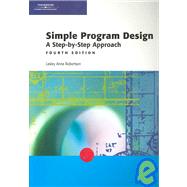
What is included with this book?
| Preface | xi | ||||
| 1 Program design | |||||
|
|||||
|
2 | (2) | |||
|
4 | (1) | |||
|
5 | (1) | |||
|
6 | (1) | |||
|
7 | (3) | |||
|
10 | (2) | |||
| 2 Pseudocoele | |||||
|
|||||
|
12 | (3) | |||
|
15 | (1) | |||
|
15 | (2) | |||
|
17 | (2) | |||
| 3 Developing an algorithm | |||||
|
|||||
|
19 | (4) | |||
|
23 | (2) | |||
|
25 | (8) | |||
|
33 | (1) | |||
|
33 | (3) | |||
| 4 Selection control structures | |||||
|
|||||
|
36 | (4) | |||
|
40 | (7) | |||
|
47 | (4) | |||
|
51 | (1) | |||
|
51 | (4) | |||
| 5 Repetition control structures | |||||
|
|||||
|
55 | (9) | |||
|
64 | (3) | |||
|
67 | (2) | |||
|
69 | (1) | |||
|
70 | (3) | |||
| 6 Pseudocoele algorithms using sequence, selection and repetition | |||||
|
|||||
|
73 | (11) | |||
|
84 | (1) | |||
|
85 | (3) | |||
| 7 Array processing | |||||
|
|||||
|
88 | (3) | |||
|
91 | (3) | |||
|
94 | (2) | |||
|
96 | (1) | |||
|
97 | (4) | |||
|
101 | (4) | |||
|
105 | (1) | |||
|
105 | (5) | |||
| 8 First steps in modularisation | |||||
|
|||||
|
110 | (3) | |||
|
113 | (2) | |||
|
115 | (1) | |||
|
116 | (4) | |||
|
120 | (4) | |||
|
124 | (1) | |||
|
124 | (8) | |||
|
132 | (1) | |||
|
133 | (4) | |||
| 9 Further modularisation, cohesion and coupling | |||||
|
|||||
|
137 | (6) | |||
|
143 | (6) | |||
|
149 | (5) | |||
|
154 | (1) | |||
|
154 | (7) | |||
| 10 General algorithms for common business problems | |||||
|
|||||
|
161 | (1) | |||
|
162 | (2) | |||
|
164 | (4) | |||
|
168 | (5) | |||
|
173 | (6) | |||
|
179 | (1) | |||
|
180 | (8) | |||
| 11 Detailed object-oriented design | |||||
|
|||||
|
188 | (5) | |||
|
193 | (10) | |||
|
203 | (4) | |||
|
207 | (3) | |||
|
210 | (1) | |||
|
210 | (3) | |||
| 12 Simple object-oriented design for multiple classes | |||||
|
|||||
|
213 | (4) | |||
|
217 | (15) | |||
|
232 | (1) | |||
|
233 | (2) | |||
| 13 Conclusion | |||||
|
|||||
|
235 | (1) | |||
|
236 | (3) | |||
| Appendix 1 Flowcharts | |||||
|
|||||
|
239 | (3) | |||
|
242 | (4) | |||
|
246 | (2) | |||
|
248 | (6) | |||
|
254 | (2) | |||
|
256 | (1) | |||
|
257 | (8) | |||
|
265 | (24) | |||
|
289 | (14) | |||
| Appendix 2 Nassi-Schneiderman diagrams | |||||
|
|||||
|
303 | (2) | |||
|
305 | (2) | |||
|
307 | (2) | |||
|
309 | (4) | |||
|
313 | (1) | |||
|
314 | (1) | |||
|
315 | (6) | |||
| Appendix 3 Special algorithms | |||||
|
|||||
|
321 | (3) | |||
|
324 | (5) | |||
| Appendix 4 Translating pseudocoele into computer languages: quick reference chart | 329 | (7) | |||
| Glossary | 336 | (7) | |||
| Index | 343 |
The New copy of this book will include any supplemental materials advertised. Please check the title of the book to determine if it should include any access cards, study guides, lab manuals, CDs, etc.
The Used, Rental and eBook copies of this book are not guaranteed to include any supplemental materials. Typically, only the book itself is included. This is true even if the title states it includes any access cards, study guides, lab manuals, CDs, etc.